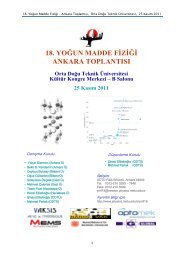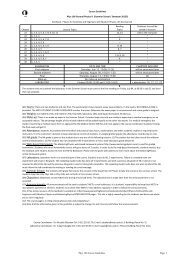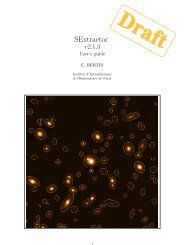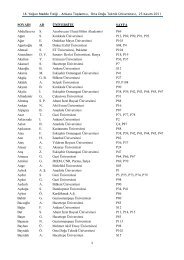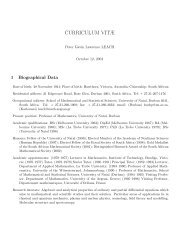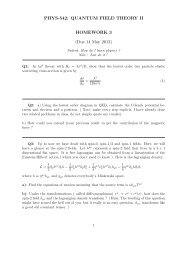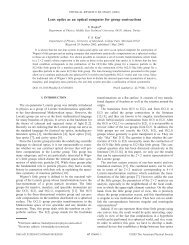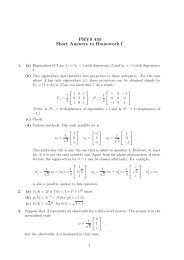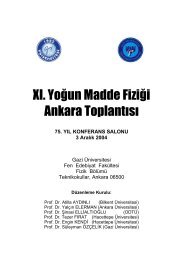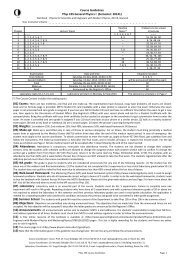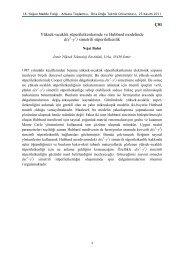A Crash Course on Quantum Mechanics
A Crash Course on Quantum Mechanics
A Crash Course on Quantum Mechanics
Create successful ePaper yourself
Turn your PDF publications into a flip-book with our unique Google optimized e-Paper software.
This relati<strong>on</strong> is called Bohr frequency c<strong>on</strong>diti<strong>on</strong>. In the absorpti<strong>on</strong> of light, the samerelati<strong>on</strong>ship has to be satisfied as well. It is obvious that the orbit with lowest energy isabsolutely stable. Therefore, the absence of a quantized orbit with lower energy preventsthe electr<strong>on</strong>s in atoms from radiating.When Bohr have solved the Hydrogen atom problem, it has been seen that all lines inthe emissi<strong>on</strong> spectrum of Hydrogen atom can be predicted. It can also give the correctfrequencies for the singly i<strong>on</strong>ized Helium atom, which is <strong>on</strong>ly different from Hydrogen bythe fact that its nucleus c<strong>on</strong>tains two prot<strong>on</strong>s. These successes of the Bohr’s theory inexplaining the spectra led to its fast recogniti<strong>on</strong>.Experiments carried out by Franck and Hertz (Nobel in 1926) provided a direct way ofshowing that the energy levels exist. In these experiments, electr<strong>on</strong>s are accelerated to aknown energy and passed through a low density gas. When electr<strong>on</strong> energies are low, theelectr<strong>on</strong>-atom collisi<strong>on</strong>s are elastic. But if the electr<strong>on</strong>s have sufficiently high energy, theninelastic collisi<strong>on</strong>s can occur. In inelastic collisi<strong>on</strong>s, part of the initial energy is c<strong>on</strong>vertedto excite the atom (say from level-1 to level-2). In that case, it is observed that the currentdecreases and the gas starts to emit light.Old quantum theory c<strong>on</strong>tained a number of unjustifiable assumpti<strong>on</strong>s and people knewthat it was just an approximate form of a correct theory. But, with the lack of the correct<strong>on</strong>e, they kept <strong>on</strong> using it until 1926. It is quite interesting to see that during this period,a lot of informati<strong>on</strong> is gained about the structure of atoms by investigating their spectraand using the old quantum theory. When the atoms are subjected to c<strong>on</strong>stant electric(Stark effect, Nobel 1919) or magnetic (Zeeman effect) fields, the energies and the spectralfrequencies change. From these kind of experiments, they could understand the natureof quantum numbers. The spin of the electr<strong>on</strong>s and their associated quantum numbers(Goudsmit and Uhlenbeck) and the exclusi<strong>on</strong> principle of Pauli (Nobel 1945) are proposedduring this period.Let me menti<strong>on</strong> <strong>on</strong>e thing that is wr<strong>on</strong>g with old quantum theory, a point that Iwill return later. Remember that to produce light with frequency f, there should be anoscillator with the same frequency. With the Bohr frequency c<strong>on</strong>diti<strong>on</strong>, this implies that inn to m transiti<strong>on</strong>, there should be a charge oscillating with frequency f = (E n −E m )/h. Theobvious candidate would be the periodic moti<strong>on</strong> of electr<strong>on</strong>s in periodic orbits. However,when you calculate the frequencies of this moti<strong>on</strong>, you will see that the frequencies of nth ormth orbit are different from f. However, if you c<strong>on</strong>sider large successive quantum numbers(n + 1 to n transiti<strong>on</strong>, n ≫ 1), then it can be shown that Eq. (1) leads to approximatelymatching values of all these three frequencies. There appears to be no problem for largequantum numbers, but an explanati<strong>on</strong> is necessary for the small <strong>on</strong>es.Louis de Broglie, 1924. A significant development was the PhD thesis of Louis deBroglie. In there, he suggested that there are waves accompanying each particle with awavelengthλ = h pwhere p is the momentum of the particle. He did not speculate <strong>on</strong> the nature of thesewaves (<strong>on</strong>ly later he proposed the guiding-wave interpretati<strong>on</strong>). Experimental verificati<strong>on</strong>,7
For the energy-frequency relati<strong>on</strong>ship, we use Planck’s formula (why?): E = hf = ¯hω.With this we can make the associati<strong>on</strong>E → i¯h ∂ ∂t.Inserting all of this into the equati<strong>on</strong> for energy we get the time dependent Schrödingerequati<strong>on</strong>∂ψ(x, t)i¯h = − ¯h2 ∂ 2 ψ(x, t)+ V (x)ψ(x, t) .∂t 2m ∂x 2Before going further, let us c<strong>on</strong>clude the historical development. Before Schrödinger publishedhis wave equati<strong>on</strong>, Werner Heisenberg have developed his own equati<strong>on</strong>s that wenow call as “matrix mechanics”. Both theories appeared to be describing correctly allphysical problems that can be solved at that time. After a brief period of quarrel betweenthese two people <strong>on</strong> which theory is correct, Schrödinger was able to show the equivalenceof both theories. Heisenber w<strong>on</strong> the Nobel Prize in 1932, and Schrödinger together withDirac w<strong>on</strong> it in 1933.<strong>Quantum</strong> <strong>Mechanics</strong>How the Schrödinger equati<strong>on</strong> is c<strong>on</strong>structed from a given Hamilt<strong>on</strong>ian functi<strong>on</strong> should beobvious. We replace various physical quantities by certain differential operators. Momentumis replaced by⃗p → ˆ⃗p = ¯h i ⃗ ∇ , ˆp x = ¯h i∂∂x , ˆp y = ¯h ∂i ∂yFrom now <strong>on</strong> I will use hats to represent operators.Hamilt<strong>on</strong>ian functi<strong>on</strong> we get the Hamilt<strong>on</strong>ian operatorĤ = H(ˆ⃗p, ⃗r) = − ¯h22m ∇2 + V (⃗r) .We can also c<strong>on</strong>sider the positi<strong>on</strong> as an operator with the identificati<strong>on</strong>ˆ⃗r = “multiply by” ⃗r .etc.Using these replacements in theThe Schrödinger equati<strong>on</strong> isi¯h ∂ψ = Ĥψ . (2)∂tWe see that the Hamilt<strong>on</strong>ian operator, just like the case in classical mechanics, c<strong>on</strong>tainsthe informati<strong>on</strong> for the time-development of the wave. The extensi<strong>on</strong> to more than <strong>on</strong>eparticle case is also obvious. In that case the wavefuncti<strong>on</strong> is a functi<strong>on</strong> of the coordinatesof all the particles (plus time).To solve the equati<strong>on</strong> (2) we need to impose the boundary c<strong>on</strong>diti<strong>on</strong> that the wavefuncti<strong>on</strong>goes to zero at infinities (when we see the interpretati<strong>on</strong> of the wavefuncti<strong>on</strong>, wewill see that the correct c<strong>on</strong>diti<strong>on</strong> is square integrability). First, c<strong>on</strong>sider the eigenvalueequati<strong>on</strong>Ĥϕ n = E n ϕ n10
which is nothing other than the time-independent Schrödinger equati<strong>on</strong> with energy E n .For bound states of particles, the eigenvalues of this equati<strong>on</strong> will be discrete, the quantizati<strong>on</strong>of energy is the natural product of the wave equati<strong>on</strong>. If the eigenfuncti<strong>on</strong>s ϕ nform a complete set for the space of possible wavefuncti<strong>on</strong>s, then the general soluti<strong>on</strong> ofEq. (2) can be written asψ(⃗r, t) = ∑ nc n e −iEnt/¯h ϕ n (⃗r) .Now, at this point we need to say something about the interpretati<strong>on</strong> of the wavefuncti<strong>on</strong>.Schrödinger assumed that the charge density of an electr<strong>on</strong> in a Hydrogen atom canbe expressed asρ(⃗r, t) = (−e) |ψ(⃗r, t)| 2 .(This interpretati<strong>on</strong> is not wr<strong>on</strong>g for a single particle.) So we have a distributi<strong>on</strong> of chargein space. The total charge should necessarily be (−e), for this reas<strong>on</strong> we have the c<strong>on</strong>diti<strong>on</strong>∫|ψ(⃗r)| 2 d 3 ⃗r = 1 .In other words, ψ should be square integrable and moreover its norm should be equal to 1.First c<strong>on</strong>sider the case where ψ is formed by a single eigenfuncti<strong>on</strong> of Ĥ, say the <strong>on</strong>ewith quantum number n. The wavefuncti<strong>on</strong> isψ(⃗r, t) = ϕ n (⃗r)e −iE nt/¯h.In that case the charge density at time t isρ(⃗r, t) = (−e) |ϕ n (⃗r)| 2 ,In other words it will be time-independent. As a result, there w<strong>on</strong>’t be any radiati<strong>on</strong>emitted either. What prevents the Hydrogen atom from collapsing is that lack of time dependence.Because of this, the states represented by the eigenfuncti<strong>on</strong>s of the Hamilt<strong>on</strong>ianare called “stati<strong>on</strong>ary states”.Now c<strong>on</strong>sider a wavefuncti<strong>on</strong> which is a superpositi<strong>on</strong> of two eigenstates of the Hamilt<strong>on</strong>ian,say the nth and mth levels. In that case the wavefuncti<strong>on</strong> is likeψ(⃗r, t) = aϕ n (⃗r)e −iE nt/¯h + bϕ m (⃗r)e −iE mt/¯h.If we calculate the charge density, this time we find a time-dependent expressi<strong>on</strong>,ρ(⃗r, t) = (−e) |ψ(⃗r, t)| 2= (−e) ( |a| 2 |ϕ n (⃗r)| 2 + |b| 2 |ϕ m (⃗r)| 2) +((−e)a ∗ bϕ n (⃗r) ∗ ϕ m (⃗r) exp i E )n − E mt + c.c.¯h( ) ( )En − E mEn − E m= ρ av (⃗r) + ρ 1 (⃗r) cos t + ρ 2 (⃗r) sin t¯h¯h11
An important quantity that we would like to work with is the average value of measurements.We suppose that the particle is repeatedly prepared in the state represented by thewavefuncti<strong>on</strong> ψ(⃗r) and then the measurement of A is carried out. The statistical averageof the results obtained is represented by 〈A〉 and is frequently called as the “expectati<strong>on</strong>value”. It can be expressed as〈A〉 = ∑ nλ n |d n | 2 = ∑ nmd ∗ nλ m d m 〈α n |α m 〉 = 〈ψ|Âψ〉 = 〈ψ|Â|ψ〉 .This expressi<strong>on</strong> is very c<strong>on</strong>venient because to calculate it we d<strong>on</strong>’t need to solve theeigenvalue equati<strong>on</strong>. We just need to know how to apply  <strong>on</strong> ψ. It can also be extendedto the average of the square of observed values〈 〉 A2= ∑ λ 2 n |d n | 2 = 〈ψ|Â2 ψ〉 = 〈ψ|Â2 |ψ〉 .nA very simple proof that  is hermitian can be given if it is postulated that theexpectati<strong>on</strong> value can be calculated as 〈A〉 = 〈ψ|Âψ〉 (without specifying the probabilities,that postulate al<strong>on</strong>e is not sufficient, but we c<strong>on</strong>tinue). Since the experimenters can <strong>on</strong>lymeasure real numbers, the expectati<strong>on</strong> value has to be real as well. If the wavefuncti<strong>on</strong> isψ, we have〈A〉 ∗ = 〈ψ|Âψ〉∗ = 〈Âψ|ψ〉 = 〈ψ|† ψ〉 ,where † is the hermitian c<strong>on</strong>jugate of the operator Â. From here, we get〈A〉 − 〈A〉 ∗ = 〈ψ|( − † )ψ〉 = 0 .Next we claim that all possible normalized wavefuncti<strong>on</strong>s are physically realizable wavefuncti<strong>on</strong>sfor the particle. Then the equati<strong>on</strong> above says that, for all functi<strong>on</strong>s with norm1, the expectati<strong>on</strong> value of  − † is 0. It is then a straightforward exercise in Hilbertspace theory to show that this implies  − † = 0, i.e.,  is hermitian.Momentum. Momentum is also a possible observable. We have said before that it isrepresented by the operator (I will c<strong>on</strong>sider the x-comp<strong>on</strong>ent of momentum)ˆp x = ¯h i∂∂x .It can be shown quite easily that it is hermitian,∫〈φ 1 |ˆp x φ 2 〉 = φ ∗ ¯h ∂φ 21i ∂x d3 ⃗r= ¯h ∫ ∂(φ∗1 φ 2 )d 3 ⃗r − ¯h ∫ ∂φ∗1i ∂x i ∂x φ 2d 3 ⃗r∫ ) ∗(¯h ∂φ1= 0 +i ∂x φ∗ 2d 3 ⃗r= 〈φ 2 |ˆp x φ 1 〉 ∗ = 〈ˆp x φ 1 |φ 2 〉= 〈φ 1 |ˆp † xφ 2 〉 ,14
which implies that ˆp x = ˆp † x. In here we have used the square integrability property todeduce that φ ∗ 1φ 2 goes to zero in the limit x → ±∞.What about the eigenfuncti<strong>on</strong>s? It can be seen that the functi<strong>on</strong> e ikx is an eigenfuncti<strong>on</strong>of ˆp x with eigenvalue ¯hk. However, e ikx is not in the Hilbert space. Physicists are notoverwhelmed by such “details” and proceed to treat these functi<strong>on</strong>s as if they were inHilbert space. For our purposes, we can c<strong>on</strong>sider the following Fourier transform∫1ψ(⃗r) = φ((2π) ⃗ k)e i⃗k·⃗r d 3 ⃗ k .3/2We then note the Parseval’s identity∫|ψ(⃗r)| 2 d 3 ⃗r =∫ ∣ ∣∣φ( ⃗ k)∣ ∣∣2d3⃗ k = 1 .∣Seeing this equati<strong>on</strong> as the way Born did, we can interpret ∣φ( ⃗ k) ∣ 2 as the probability densityfor momentum distributi<strong>on</strong>. In other words, the probability of measuring the momentumto be ¯h ⃗ k within a “ ⃗ ∣k-volume” of ∆V k is ∣φ( ⃗ k) ∣ 2 ∆V k . The functi<strong>on</strong> φ( ⃗ k) is called themomentum-space wavefuncti<strong>on</strong>.Lack of Determinism. We have talked about probabilities above, but we haven’t saidanything about how each individual outcome of measurements occur. The previously seennoti<strong>on</strong>s of probability in physics have always been statistical. The outcomes of experimentsare not random, but since we cannot precisely measure the initial c<strong>on</strong>diti<strong>on</strong>s of physicalsystems, the outcomes appear random to us. So the probabilities actually reflect our lack ofknowledge about the system in questi<strong>on</strong>. If we knew a lot about the system we can predictthe outcomes. For example in coin flip experiments, you need to know the exact value ofimpulse you give to the coin and the exact place you hit to be able to determine if it willend up heads or tails. Most of the time, the system is chaotic so that uncertainties in initialvalues prevent you from making a predicti<strong>on</strong>. So, you are stuck with the probabilities.In quantum mechanics however, the c<strong>on</strong>cept of probability is included at its roots, distinctfrom the classical noti<strong>on</strong> of probability. C<strong>on</strong>sider the measurement of the observableÂ. I am going to use the notati<strong>on</strong> above for eigenfuncti<strong>on</strong>s. Suppose the wavefuncti<strong>on</strong> ofthe particle is ψ(⃗r) and its expansi<strong>on</strong> isψ(⃗r) = ∑ nd n α n (⃗r) .We have said that measurement of A yields the eigenvalue λ n with probability |d n | 2 . Ifthere were really a way to determine this outcome (namely λ n ), then this informati<strong>on</strong>is not c<strong>on</strong>tained in the wavefuncti<strong>on</strong>, ψ(⃗r). If you insist that the outcomes are realizeddeterministically, then you need to invent new variables other than the wavefuncti<strong>on</strong>.However, the experiments carried out up to now shows us that <strong>on</strong>ly the wavefuncti<strong>on</strong> andthe Schrödinger equati<strong>on</strong> is necessary to explain all of them. You have two opti<strong>on</strong>s: Youeither extend the theory and introduce new variables (these are called Hidden VariableTheories) or you stick with the present status and accept n<strong>on</strong>-deterministic aspect of it.15
The Copenhagen interpretati<strong>on</strong> follows the sec<strong>on</strong>d <strong>on</strong>e. As a result, before actuallymeasuring A, you have no way of predicting which outcome will be the obtained. Also,any <strong>on</strong>e of them with n<strong>on</strong>zero d n can really occur. During the experiment, nature somehowdecides which <strong>on</strong>e should appear. This lack of determinism terrified a lot of people.Einstein was their leader. Bohr was the defender of the interpretati<strong>on</strong>. After a lot ofdiscussi<strong>on</strong>, this view gained weight. But even today there are serious works c<strong>on</strong>centrating<strong>on</strong> other possible interpretati<strong>on</strong>s.Collapse. To complete the theory, we have to menti<strong>on</strong> <strong>on</strong>e last feature. C<strong>on</strong>sider anexperiment where you measure A. After some indeterministic measurement process we get<strong>on</strong>e particular result, λ n . Now, suppose that we measure A again immediately after thefirst measurement. We need to do this immediately because with time, the wavefuncti<strong>on</strong>could change. Normally we should obtain exactly the same result. In other words, bothexperiments should give the same value λ n . For a correct measurement c<strong>on</strong>cept we needto have this feature. For this reas<strong>on</strong>, the sec<strong>on</strong>d experiment has no uncertainty in it. Ifthis is so, then the first measurement of A should have caused a disc<strong>on</strong>tinuous change inthe wavefuncti<strong>on</strong> to the eigenfuncti<strong>on</strong> of  corresp<strong>on</strong>ding to λ n.To summarize, suppose that you make a measurement at time t = t meas . Prior themeasurement, the wavefuncti<strong>on</strong> isψ(⃗r, t = t meas − ɛ) = ∑ md m α m (⃗r) ,which can be anything. If the measurement yields A = λ n , then the wavefuncti<strong>on</strong> justafter the measurement has to beψ(⃗r, t = t meas + ɛ) = α n (⃗r) .In other words, the effect of the measurement <strong>on</strong> the wavefuncti<strong>on</strong> is a projecti<strong>on</strong> to aneigenfuncti<strong>on</strong> (or eigenspace) of  and re-normalizati<strong>on</strong>. This is called the collapse of thewavefuncti<strong>on</strong>.It can be seen that the measurement introduces an unavoidable change in the wavefuncti<strong>on</strong>.A change that destroys all informati<strong>on</strong> that is carried by the wavefuncti<strong>on</strong> beforethe measurement. So, measurement in quantum mechanics does not have the c<strong>on</strong>venti<strong>on</strong>almeaning of “learning”, its meaning would be more like “changing and pretending that youhave learned”.State. In quantum mechanics, the wavefuncti<strong>on</strong> ψ(⃗r, t) c<strong>on</strong>tains all informati<strong>on</strong> that youcan ever learn about the particle. For this reas<strong>on</strong>, it is frequently referred as the state. Forexample, if you know the precise state at a certain time, then you can calculate the state atany other time by integrating the Schrödinger equati<strong>on</strong>. The corresp<strong>on</strong>ding noti<strong>on</strong> of statein classical mechanics would be its positi<strong>on</strong> and momentum: (⃗r, ⃗p), which is a point in thesix dimensi<strong>on</strong>al phase space. In quantum mechanics, however, the state space becomes aninfinite dimensi<strong>on</strong>al Hilbert space.C<strong>on</strong>sider now the positi<strong>on</strong> property of particle in a state ψ(⃗r). Since the wavefuncti<strong>on</strong>is distributed in space, there is no single definite positi<strong>on</strong> which we can say the particle is16
located. Measurement of positi<strong>on</strong> gives us <strong>on</strong>ly <strong>on</strong>e of these possibilities, but before themeasurement each positi<strong>on</strong> is a possibility.There is an interpretati<strong>on</strong> which you might hear a lot which goes like this: “Particleis actually somewhere but we d<strong>on</strong>’t know where it is”. This sentence actually assumesthat state=(ψ, ⃗r real ), where ⃗r real is the supposed real positi<strong>on</strong> of particle. In other words,it assumes that there are more things to know about the particle than the wavefuncti<strong>on</strong>.This is a hidden variable theory and is entirely different from quantum mechanics.In quantum mechanics we might state the same thing as “particle is everywhere” which,at first sight, might look c<strong>on</strong>fusing. Another alternative statement is “there is no meaningof questi<strong>on</strong> ‘where is it?’ without actually measuring it”. It appears that the classicalnoti<strong>on</strong>s of definite positi<strong>on</strong> and definite momentum cannot be directly carried over toquantum mechanics. We have noti<strong>on</strong>s of positi<strong>on</strong> and momentum in quantum mechanicsbut their nature is different from our classical noti<strong>on</strong>s.This situati<strong>on</strong> is similar to the noti<strong>on</strong> of absolute time we meet in relativity. Absolutetime is a c<strong>on</strong>cept which appears to be true in the n<strong>on</strong>-relativistic limit. Of course such anoti<strong>on</strong> is invalid, and we will make a lot of mistakes if we try to directly carry it over torelativistic problems. Same in quantum mechanics. We should, then, get rid of the noti<strong>on</strong>sof definite values of some mechanical quantities.Uncertainties. We d<strong>on</strong>’t have definite values of positi<strong>on</strong> and momentum, but there isalso a limitati<strong>on</strong> <strong>on</strong> how close we can get to definiteness. A mathematical measure of thisis the standard deviati<strong>on</strong> of measurement results which is frequently called uncertainty.For example, the uncertainty in x-comp<strong>on</strong>ent of positi<strong>on</strong> is∆x 2 = 〈 (x − 〈x〉) 2〉 ∫= |x − 〈x〉| 2 |ψ| 2 .Remember that this gives the deviati<strong>on</strong> of measurement results from the average in a seriesof repeated measurements <strong>on</strong> the same state ψ. In other words, each time the particle hasto be re-prepared in the same state. Uncertainty in momentum is defined similarly,∆p 2 x = 〈 (p x − 〈p x 〉) 2〉 .Now, it appears that the positi<strong>on</strong> and momentum operators corresp<strong>on</strong>ding to the samecomp<strong>on</strong>ent do not commute with each other. They have a commutatorˆxˆp x − ˆp xˆx = i¯h .This commutati<strong>on</strong> relati<strong>on</strong> implies that the product of respective uncertainties has a lowerbound. The proof goes like this. First note that∆x 2 = 〈ψ| (ˆx − 〈x〉) 2 ψ〉= 〈(ˆx − 〈x〉) ψ| (ˆx − 〈x〉) ψ〉 .Let us define two vectors in the Hilbert space byφ 1 = (ˆx − 〈x〉)ψφ 2 = (ˆp x − 〈p x 〉)ψ17
In that case, the uncertainties can be expressed as norms of these vectors: ∆x = ||φ 1 || and∆p x = ||φ 2 ||.At this point we can use Schwarz inequality∆x∆p x = ||φ 1 || · ||φ 2 || ≥ |〈φ 1 |φ 2 〉| .Now, it appears that we can calculate the imaginary part of the inner product 〈φ 1 |φ 2 〉 asIm〈φ 1 |φ 2 〉 = 1 2i (〈φ 1|φ 2 〉 − 〈φ 2 |φ 1 〉)= 1 2i [〈(ˆx − 〈x〉)ψ|( ˆp x − 〈p x 〉)〉 − c.c.]= · · ·= 1 2i 〈ψ|(ˆxˆp x − ˆp xˆx)ψ〉= ¯h 2.Since |〈φ 1 |φ 2 〉| is greater than its imaginary part, we have∆x∆p x ≥ ¯h 2.This is called the Heisenberg uncertainty relati<strong>on</strong>.Note that it is a relati<strong>on</strong> about the same state ψ for possible positi<strong>on</strong> or momentummeasurements which have not been carried out. It tells you that you cannot prepare astate where you can choose uncertainties in positi<strong>on</strong> and momentum to be as small asyou wish. It also tells you that you cannot measure positi<strong>on</strong> and momentum at the sametime (∆x, ∆p x in collapsed state). If you have measured the positi<strong>on</strong> with a very smalluncertainty, then the equati<strong>on</strong> tells you that the uncertainty in momentum have got larger(in the collapsed state again).Postulates. Now we need to generalize what we have said above about the basic featuresof quantum mechanics to other possibly more complicated cases. The case of N particlesseems simple, you just need to c<strong>on</strong>sider complex-valued square integrable functi<strong>on</strong>s ofN-positi<strong>on</strong>s (3N real variables), ψ(⃗r 1 , · · · , ⃗r N , t). There are cases where the number ofparticles can change, which is the situati<strong>on</strong> particle physicists meet a lot. For example,in a neutr<strong>on</strong> decay, a neutr<strong>on</strong> is c<strong>on</strong>verted into three distinct particles. So, you shouldbe able to use N = 1 particle wavefuncti<strong>on</strong>s together with N = 3 particle wavefuncti<strong>on</strong>s.There is also the spin degree of freedom of electr<strong>on</strong>s which needs <strong>on</strong>ly a two dimensi<strong>on</strong>alHilbert space. In each of these cases the Hilbert space and the operators corresp<strong>on</strong>dingto observables have to be c<strong>on</strong>structed. But the basic machinery of quantum mechanicsremains the same. I am going to state these as two postulates, first <strong>on</strong>e being universallyaccepted and the sec<strong>on</strong>d <strong>on</strong>e being the c<strong>on</strong>troversial <strong>on</strong>e.18
Postulate 1: States. For every isolated physical system, there is a separable, complexHilbert space describing the states of the system, such that- Every normalized vector, |ψ〉, represents a state- To every physically realizable state there is a normalized vector that represents it- Overall phase factors do not change the state (in other words |ψ〉 and e iθ |ψ〉 representthe same state)(The three statements above basically tells us that there is a <strong>on</strong>e-to-<strong>on</strong>e corresp<strong>on</strong>dencebetween states and rays in the Hilbert space.)- There is a linear, unitary time-evoluti<strong>on</strong> operator Û(t 2, t 1 ), which, when acts <strong>on</strong> thestate at time t 1 gives the state at time t 2 . (In other words, if |ψ(t)〉 is the state of thesystem at time t, then Û(t 2, t 1 ) |ψ(t 1 )〉 = |ψ(t 2 )〉.)Postulate 2: Observables. For every measurable quantity A, there is a corresp<strong>on</strong>dinghermitian operator  such thatIf λ n are its eigenvalues and |α n 〉 are its eigenvectors chosen such that they form anorth<strong>on</strong>ormal basis |α n 〉 = λ n |α n 〉 , 〈α n |α m 〉 = δ nm ,and if A is measured when the system is in state |ψ〉,- The result is <strong>on</strong>e of the eigenvalues, λ n ,- the probability of that result is p n = |〈α n |ψ〉| 2 ,- and the state collapses to |α n 〉 after the measurement.The Schrödinger equati<strong>on</strong> itself can be obtained from the time evoluti<strong>on</strong> operator wherewe define the Hamilt<strong>on</strong>ian at time t bywhich implies that Ĥ(t) is hermitian.i¯h ∂ ∂tÛ(t, t 1) = Ĥ(t)Û(t, t 1) ,Schrödiger’s Cat. An interesting feature of the first postulate is that it allows us totake linear combinati<strong>on</strong>s of a number of states and in this way c<strong>on</strong>struct new, physicallyrealizable states. The linear combinati<strong>on</strong>s of vectors are usually called superpositi<strong>on</strong>s,a word borrowed from wave phenomena. The possibility of forming superpositi<strong>on</strong>s isthe most important distinctive feature of quantum mechanics that separates it from theclassical <strong>on</strong>es.A strange example is proposed by Schrödiger. He also showed how such states can beformed in practice. C<strong>on</strong>sider a cat as a physical system. We know that there is a Hilbertspace that describes all possible states of that cat. Let |A〉 be <strong>on</strong>e particular state where19
the cat is alive. Let |D〉 be another state where the cat is dead. Postulate 1 tells us thatthere is a state of the cat represented by the following vector of the Hilbert space,|ψ〉 = 1 √2(|A〉 + |D〉) .There are a number of things which is strange about this state. The cat is neither alivenor dead, it is in a strange state foreign to our classical senses. We might also say that itis “both dead and alive” at the same time.Of course, to keep the cat in that state, you have to isolate it inside a box becauseseeing it amounts to a measurement (and measurement means collapse, we d<strong>on</strong>’t wantthat). Also, the walls of the box should be perfectly isolated because hearing the voiceof the cat (or not hearing it) also amounts to a measurement. Can such states be reallyprepared? The postulates of quantum mechanics does not state anything like “these lawsdo not apply to such and such bodies”. So, it appears that, all macroscopic objects as wellas all microscopic <strong>on</strong>es should obey quantum mechanics (this is also the basic difficulty withpostulate 2 where it is assumed that system is quantum mechanical but the experimenteris classical, but that is another matter).Now, if we open the box and measure “what the cat is doing” then the state willcollapse to the state |A〉 or to |D〉, i.e., we will see it as either alive or dead. It appearsthat with the means available to us, we cannot do any other measurement, so we willalways cause the destructi<strong>on</strong> of the state |ψ〉. However, it is possible to prepare sufficientlymacroscopic objects in such superpositi<strong>on</strong> states. In an experiment carried out a few yearsago, SQUIDs which c<strong>on</strong>tain billi<strong>on</strong>s of electr<strong>on</strong>s, are made to enter into a superpositi<strong>on</strong> oftwo macroscopically distinct states. In that experiment, however, they had a method todetermine whether the device is in the superpositi<strong>on</strong> state or not (in other words, therewas an observable with |ψ〉 being the eigenvector). Is it possible to c<strong>on</strong>struct such anobservable (an experimental technique) that can show that the cat really is in the state|ψ〉 and not in |A〉 or |D〉? Until we answer this questi<strong>on</strong>, we cannot answer what the catis really doing. But, it appears that, there is no fundamental macroscopic limit <strong>on</strong> theapplicability of quantum mechanics.20



